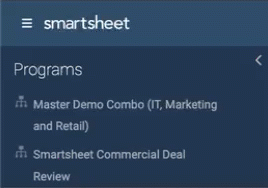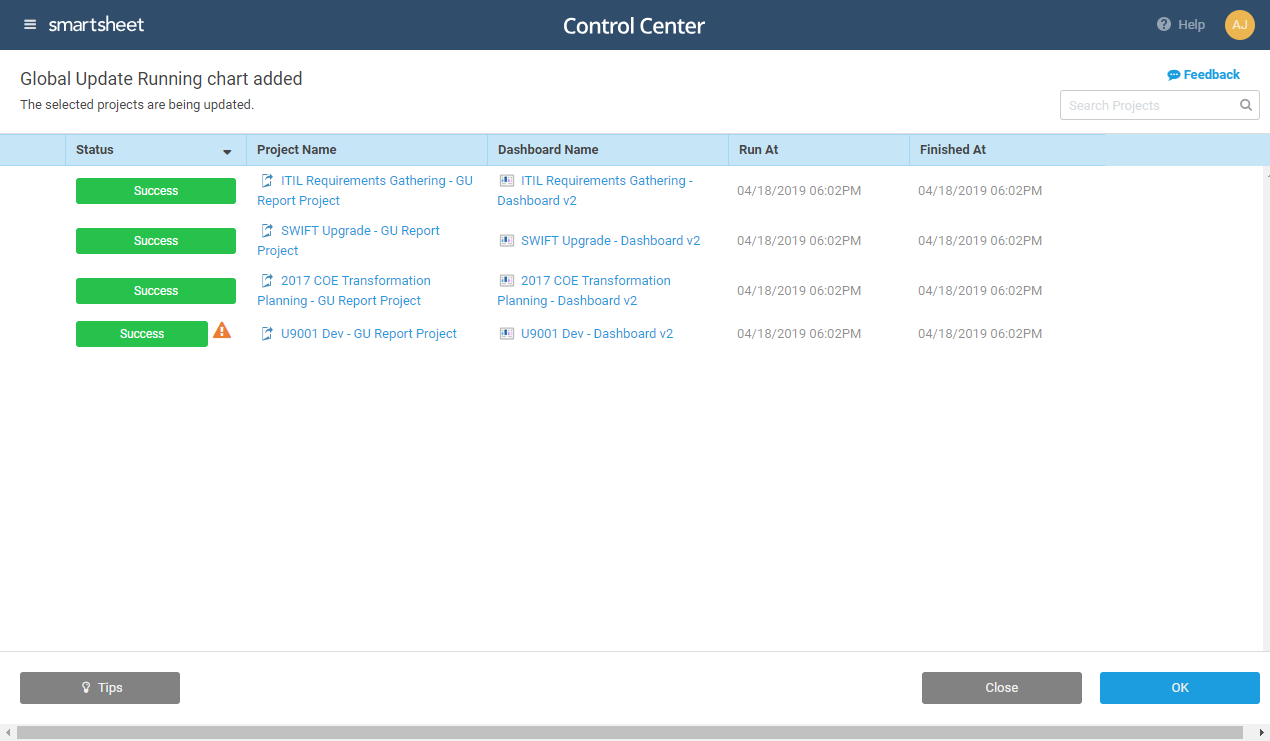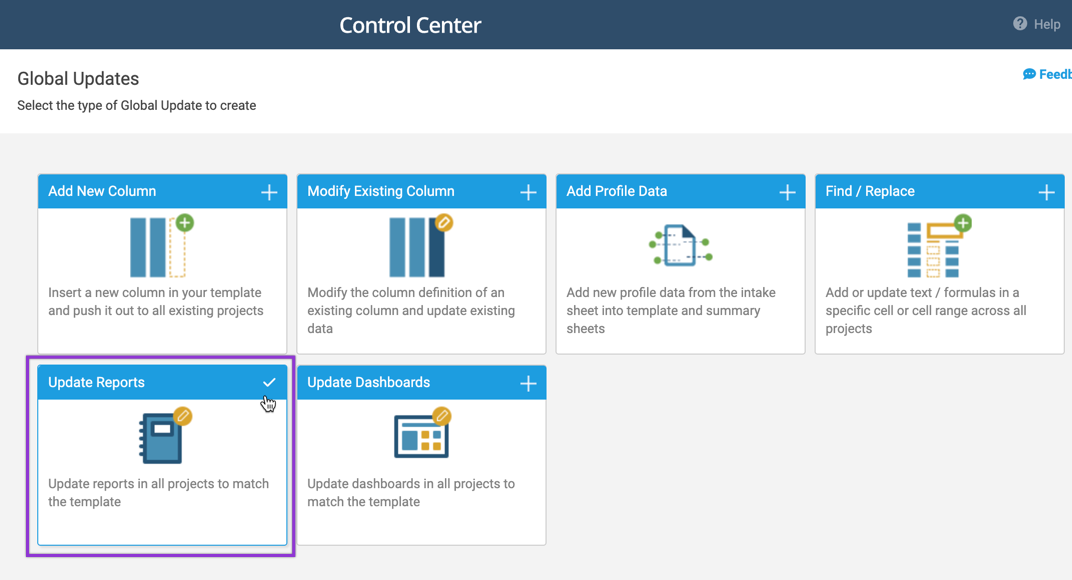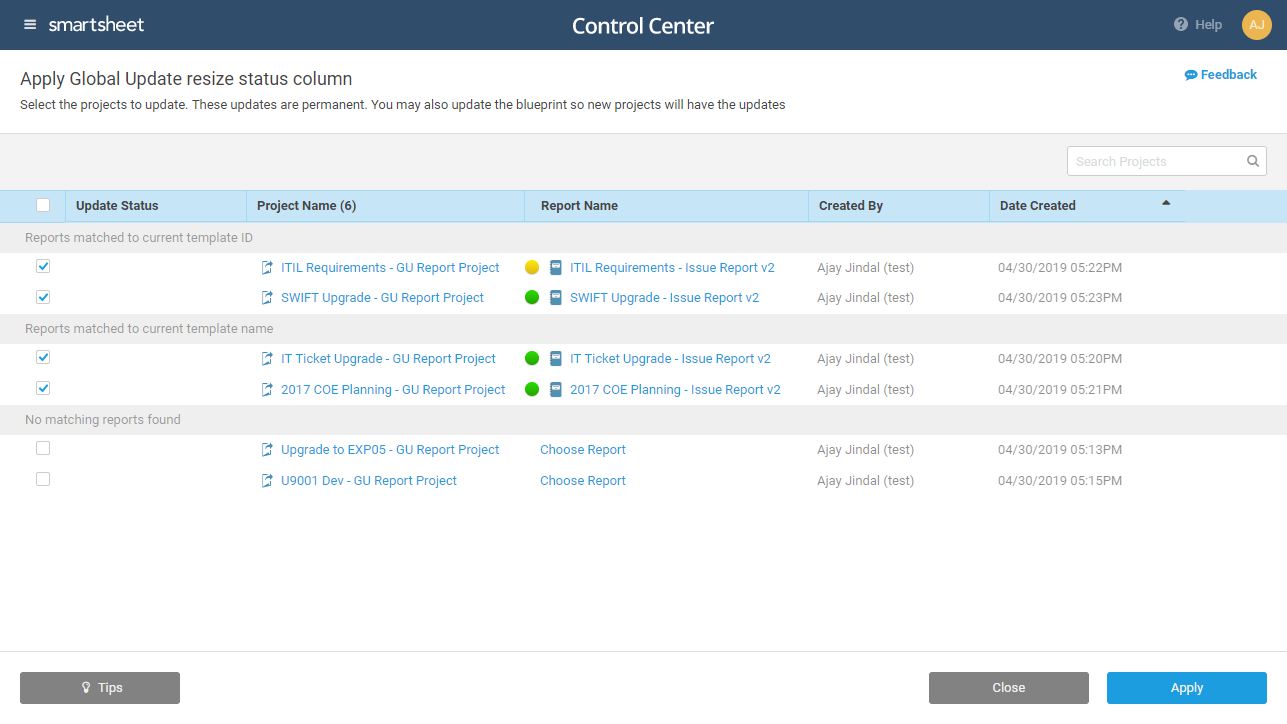As project requirements evolve, deploy change to all sheets, reports, and dashboards within a Control Center portfolio.
Smartsheet Control Center: Make Global Updates to your projects
Global Update types
Before you create and run Global Updates, familiarize yourself with the available Global Update types and their capabilities. Global Updates offers the following options:
- Add New Column: Insert a new column in your template and push it out to all existing projects.
- Modify Existing Column: Modify the column definition of an existing column and update existing data.
- Add Profile Data: Add new Profile Data from the intake sheet into the template and summary sheets.
- Find/Replace: Add or update text/formulas in a specific cell or cell range across all projects.
- Update Reports: Update reports in all projects to match the template.
- Update Dashboards: Update dashboards in all projects to match the template.
Global Updates don't apply to title widgets that link to Smartsheet items. To implement this change, you need to edit the individual dashboard.
Create a new Global Update
- Log into Control Center, or select it from the App Launcher in Smartsheet.
- Open the three-line menu in the top left corner and select the program to update.

- Open the program and select Manage Program in the upper right corner.
- Select Global Updates > New Update.
- Select the type of update you want to perform.
When you select an update, the plus sign on the tile changes to a checkmark.
- Select Next and enter your update details.
- In the bottom right corner, select Create & Run.
Test and validate your changes
Testing is required before you can confirm and push your changes out.
Select Create & Run to test and validate the proposed update against active projects and sheets.
The test creates a temporary copy of a project, ensuring you don’t apply changes until you’re certain you want them.
- On the Test Global Update page, select a project and then select Apply Test at the bottom of the page.
When the test copy is ready, the Status column on the Test Global Update page changes from New to Success.
Hover over the Success message to see an update summary.
- Select Open Test to review the test sheet, report, or dashboard and confirm the test updates.
To edit the update, select Close to close the test, make your changes, and run the test again.
Select Close to return to the Update Summary page to test the update on additional projects. Select Test Update, and select the project to test. Do this as many times as you like until you're confident about your changes.
- Once you’ve confirmed your update works as desired, close the test and return to the Test Global Update page.
- Select Confirm to go to the Update Summary page.
Confirm the results and apply the update
You have one last chance to review and confirm the proposed changes and select where you want updates applied.
- Review the Update Summary page and verify your updates.
- Select Apply Update.
- On the Apply Update page, select the projects you want to update.
If you want to update your templates, check Apply update to the base project template(s).
- Select Apply. You get a notice telling you the changes are permanent. Select Yes to complete the update.
Global Updates remain on the Global Updates page. You can run them whenever you want. Select the update and run it as above.
You can’t edit a Global Update once you’ve selected Apply test.
For answers to common questions related to Global Updates and Smartsheet Control Center generally, see Smartsheet Control Center FAQ.
Control Center Global Updates: Dashboards
Use Global Updates when you have made the following changes to a dashboard template:
- Updated colors or branding on the dashboard
- Revisions to dashboard widgets
- Widget layout
- New or deleted widgets
Global Updates don’t apply to title widgets that link to Smartsheet items. To implement this change, you need to edit the individual dashboard.
How to use Global Updates for dashboards
Update the dashboard template
In Smartsheet, go to the blueprint source folder and make your changes directly to the dashboard template.
You can:
- Modify existing widgets
- Add new widgets
- Remove existing widgets
- Update widget layout
Create a Global Update
- In Control Center, select the program you want to work with.
- At the top of the screen, select Manage Program and then select Global Updates.
- Choose New Update and then select Update Dashboards.
- Follow the instructions in the Update Dashboard wizard.
Name the update after what it does. For example, Move budget widget.
- At the bottom of the screen, select Create & Run or select Close to save the Global Update without running it.
Apply the Global Update
When you run the update, Control Center searches each project to find the dashboard that matches your template by either ID or name. It also shows you projects that don’t have a matching dashboard because they don’t match or didn’t have a dashboard when they were initially created. When you run the update, you can add the newly edited dashboard to those projects.
- Review the dashboards.
Global Updates apply to projects that match the following criteria:- Dashboards matched to current template ID: These projects contain dashboards created from the dashboard template in the blueprint source folder.
- Dashboards matched to current template name: These projects contain dashboards that have the same name as the dashboard template in the blueprint source folder.
- No matching dashboards found: When Global Updates can’t find matching dashboards, select Choose Dashboard to find a dashboard to update or to add the dashboard to the project.
- Select Apply to update all the project dashboards.
- Review the results. Warning indicators show dashboards with update issues. Hover over the warning icon to learn more.

Keep the following in mind:
- Global Updates rebuilds your entire dashboard and relinks widgets to the reports and sheets every time you run an update.
- You can’t reverse the changes, so run the update on one project and check the results before you run it on all your projects.
- Global Updates for dashboards currently don’t update widgets with the sheet summary.
- Any updates you want to apply need to be in your template dashboard before running any Global Updates.
Global Updates: Dashboards best practices
When building your dashboard templates for Control Center, structure your source data to avoid potential issues with Global Updates.
Avoid duplicate and blank values in the Primary column
Data in the Primary column is used to identify the first and last row for the range of a chart or metric widget, even if you haven’t included this column as a part of your data range. Avoid using your Primary column in widget data ranges.
If duplicate or blank values are found, the widget breaks when you run a Global Update.
Use one of the following options to structure your source data:
- To avoid duplicate values, use a row naming scheme. For example, name your Primary column rows numerically (1, 2, 3, etc.). This way, you avoid any duplicate values in the Primary column.
- Add hierarchy to manage duplicate values. This is helpful if you use the Primary column for data ranges in widgets.
By using hierarchy, you avoid issues resulting from duplicate values when running Global Updates. This is because the lookup for the Primary column returns the parent row and the child row.
With this method, it’s still possible to have duplicate values if you have two or more parent rows with the same name, and child rows with the same name under those separate parent rows.
Make sure reports used for templates contain sample data
If you use a report in a chart widget for your dashboard templates, and the report has no results to create a chart from, it doesn’t map correctly when you provision your projects. Make sure you have at least one data point in your report template.
Make sure cells referenced in template sheets have contained data
Errors related to missing data can occur if the referenced cells from a template sheet have never contained any data. To avoid this, ensure your template sheets have cell history by right-clicking the cell and selecting View Cell History.
Make changes directly to the dashboard template.
This is the most reliable method for ensuring that the dashboard matches your projects, even if you change its name. The dashboards in the project are direct children of the dashboard template in the blueprint source folder. Control Center easily identifies them as such and makes changes.
Troubleshoot updates to dashboard widgets
Widgets pull data from sheets and reports. The best way to avoid trouble with them is to make sure the sources feeding the widget are consistent and up to date.
If a widget on a project dashboard doesn’t work correctly after an update, check the following:
| Consider | Solution |
|---|---|
| Do all the sources exist in the project? | If you delete a report or sheet from the project, the widget can’t find the needed data. The same error can happen if a widget refers to a report or sheet added to the project later or if the item wasn’t created because it was optional. If the Primary column value changes during the project, it no longer matches the template, and the widget can’t find the data. |
| Is the data structured properly in the sheet? | The update locates the cells by matching the column name and value in the Primary column with the sheet template. If matches can’t be found, the widget has missing data. For Global Updates to work well, don’t reference data in the Primary column. The Primary column should contain the name of the metric, and the data should be in other columns. |
| Does the Primary Lead have permission to access the underlying project or report? | You may need to change permissions to make the data visible. |
| Widgets are left-aligned after a Global update |
|
Any failures in Global Updates for the dashboard should be checked against the Template dashboard to ensure the data is within the scope of the widgets and reports.
Control Center Global Updates: Reports
Use Global Updates when you’ve made any of the following changes to a report template:
- Deleted or added new columns
- Changed column order or width
- Changed the show or hide setting on a column
- Changed report criteria
- Changed the sort order on a column
- Added or removed sheets from a report
To update the report template:
- Add the new template report to the blueprint source folder in Smartsheet.
You can:
- Add/Remove columns
- Hide/Show columns
- Reorder columns
- Change criteria
- Change sort order
- Update the sheets that are included in the report
- Edit the Source Template Settings page in the blueprint to ensure that Control Center recognizes the new report.
- Open the program where you want to include the update.
- Select Manage Program > Global Updates > New Update > Update Reports.
- Select the new template report in the Basic Information screen.
- On the Test Global Update screen, select Choose Report in the Report Name column.
- In the Select a report to update side panel, select the radio button for Add new report.
You can also use Global Updates to update a report when you’ve changed the column name or type or when you’ve added a new column to a sheet within that report.
How to use Global Updates: Reports
Global Updates rebuilds your entire report every time you run an update. You can’t reverse changes, so run the update on one project and check the results before you run it on all your projects.
Create a Global Update in Control Center
- In Control Center, select the program you want to work with.
- At the top of the screen, select Manage Program > Global Updates.
- Select New Update and then select Update Reports.

Follow the instructions in the Update Reports wizard.
Name the update after the action it does, for example, Resize Budget Column. Leave the Update report sources toggled off unless you changed the sheets included in the report.
- Select Create & Run to test your changes, or select Close to save the Global Update without running it.
Apply the Global Update
When you run the update, Control Center looks at each project to find the report that matches your report template by either ID or name. It also shows you projects that don’t have a matching report because they don’t match or because they don’t include the report. Add the newly edited report to those projects.
- Review the selected reports.

Projects selected for the updates appear as follows:- Reports matched to current template ID: These projects contain reports created from the report template in the blueprint source folder.
- Reports matched to current template name: These projects contain reports that have the same name as the report template in the blueprint source folder.
- No matching reports found: No matching reports were found. Select the Choose Report link to manually select a report to update or add the report to the project.
Review the source mapping status on each report.
If you turned on the Update report sources toggle, the source mapping status displays how many sheets included in the scope of the report template can be matched to sheets in the project. The scope is configured in the report builder.
- Grey: The sheets included in the report don't change.
- Green: All the sheets in scope were matched successfully.
- Yellow: At least one sheet in the scope item was matched.
- Red: None of the sheets in scope items were matched.

Optional: Select the status marker to see the source mapping details for each report. On items that aren’t a complete match, select Remap sheets to map the report to the correct sheets.- Select Apply to update all the project reports.
Global Updates for reports doesn't currently update widgets with the sheet summary.

